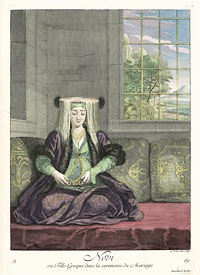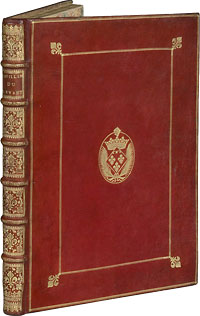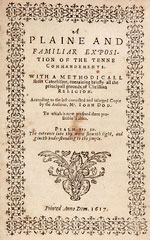 Ian McKay’s weekly column in Antiques Trade Gazette has been running for more than 30 years.
Ian McKay’s weekly column in Antiques Trade Gazette has been running for more than 30 years. Red Morocco and Maine on Vellum
Turkish Delights
Le Hay, Recueil de cent estampes représentant différentes nations du Levant, Euros 168,000 ($243,600) at Alde of Paris on May 6.
Commissioned by Charles de Ferriol, Louis XIV’s ambassador to the Sublime Porte, and produced by Le Hay of Paris, this celebrated collection of one hundred costume plates was first issued in 1714 without text. It proved a huge success, with a second issue following that same year, and in 1715, a new edition with two supplementary plates plus descriptive text.
This was a splendid example of the latter, the 102 plates all finely colored and heightened in some instances with gold and mica chips to simulate jewelry, buckles, etc. It was also a copy that would have appealed very much to French collectors, who traditionally like their books to combine fine printing and important content with fine binding and, if at all possible, exceptional provenance.
The period red morocco gilt binding of this copy bears the arms of Louise-Adelaïde d’Orléans. Also known as Mademoiselle de Chartres and Madame d’Orléans, Adelaïde was a daughter of Philippe d’Orléans and Françoise Marie de Bourbon, the latter a legitimized daughter of the Sun King himself. All this added up to a treble-estimate winning bid.
The plates became a principal source for publishers and artists throughout Europe, serving as a pattern book for other albums of Levantine costume drawings. They include not only costumes seen at the Turkish court but underline the cosmopolitan nature of eighteenth-century Constantinople and the Turkish empire in depictions of Greek, Albanian, Jewish, Armenian, Persian, Arabic, and other figures.
Four days later after this auction, Sotheby’s London took a bid of £32,500 ($53,170) on a copy of the original, one-hundred-plate, text-free issue of 1714. This too was colored throughout and heightened with gold and mica, but lacked the final double-page plate.
Puritans, Pilgrims, and Palin
John Dod & Richard Cleaver, A plaine and familiar exposition of the tenne commandements, Euros 19,840 ($28,490) at Burgersdijk & Niermans of Leiden, May 10-11.
First published in 1604, this work proved so popular among Puritans that it went through at least twenty-four editions, but the particular appeal of this 1617 copy, and the reason that it made a much higher than expected sum, is that it was printed by William Brewster, a man who, three years later, was to be one of the ‘Pilgrim Fathers’ who arrived in America on the Mayflower.
Brewster had studied briefly at Cambridge before entering the service of William Davison, a deputy to Elizabeth I’s Secretary of State Francis Walsingham, until the beheading of his cousin, Mary Queen of Scots, saw Davison, and with him Brewster, fall from courtly favor.
From 1590-1607 Brewster served as postmaster in his hometown of Scrooby in Nottinghamshire. His brother, James, was a dissident Anglican vicar, and the family home, Scrooby Manor, became a meeting place for Puritans who formed the Separatist Church of Scrooby.
Restrictions and pressures applied by the local authorities convinced this congregation of a need to emigrate to the more sympathetic atmosphere of Holland, and in 1608, having been arrested on a previous attempt to leave England, Brewster and others made their escape and eventually settled in Leiden. With the help of Thomas Brewer, he set up a printing press in the attic of his house in Choir Alley.
They printed some fourteen books, but in 1619, under pressure from the English ambassador, their type was seized by the authorities, and Brewer was arrested. Brewster escaped and, with the help of well-connected friends, obtained a land patent from the London Virginia Company on behalf of himself and his colleagues. Brewster joined the first group of pilgrims aboard the Mayflower, becoming the senior elder of the Plymouth colony, as well as its religious leader and an adviser to Governor Bradford.
Wikipedia’s entry for Brewster includes a fascinating list of those who claim descent. There are lots of Brewsters of course, but you will also find Longfellow and Nelson Rockefeller, Bing Crosby, and John Leonard Plimpton, the inventor of the roller-skate, while among politicians you will find the distinguished names of John Foster Dulles and Adlai Stevenson, along with—almost inevitably, I suppose—that of Sarah Palin!










